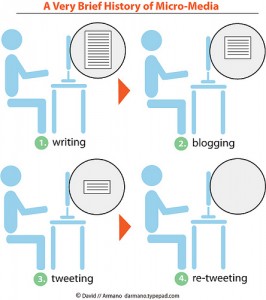This short video put a big smile on my face. Nature has the power to surprise and elate and inspire. Enjoy.
Credits:
Made by: Neels CASTILLON
DOP: Mathias Touzeris
Music: Hand-made – Alt J
Location: Marseille, France
This short video put a big smile on my face. Nature has the power to surprise and elate and inspire. Enjoy.
Credits:
Made by: Neels CASTILLON
DOP: Mathias Touzeris
Music: Hand-made – Alt J
Location: Marseille, France
Every year a Gartner survey summarizes global CIO priorities, and every year I take a very close look at the findings.
The most recent survey was conducted in the fourth quarter in 2012 and included 2,053 CIOs. These individuals span 41 countries and 36 industries. I like this annual survey because it is a well designed study into the priorities driving US$3.7 trillion of spending on information technology and personnel.
|
Top 10 Business Priorities |
Ranking |
Top 10 Technology Priorities |
Ranking |
|
| Increasing enterprise growth |
1 |
Analytics and business intelligence |
1 |
|
|
Delivering operational results |
2 |
Mobile technologies |
2 |
|
| Reducing enterprise costs |
3 |
Cloud computing (SaaS, IaaS, PaaS) |
3 |
|
| Attracting and retaining new customers |
4 |
Collaboration technologies (workflow) |
4 |
|
|
Improving IT applications and infrastructure |
5 |
Legacy modernization |
5 |
|
|
Creating new products and services (innovation) |
6 |
IT management |
6 |
|
|
Improving efficiency |
7 |
CRM |
7 |
|
|
Attracting and retaining the workforce |
8 |
Virtualization |
8 |
|
|
Implementing analytics and big data |
9 |
Security |
9 |
|
|
Expanding into new markets and geographies |
10 |
ERP Applications |
10 |
One of my favorite parts of this survey is that the technology executives are asked about business priorities first. They may be propeller heads at their core, but they understand their primary task is to find ways to align technology with business initiatives and drive strategic results. As a result, top line growth, business expansion, cost control and personnel issues are clearly present in the business priorities. The only item that I’m surprised isn’t explicit ed stated in the business priorities is accelerating product cycles and decision-making.
The technology list is dominated by newer technology that has enough of a track record of delivering disruptive results. The heightened priority suggests that these investments are moving from lab experiments to broad deployment. Cloud and mobile are the talk of Silicon Valley; it’s also found, in my estimation, in 6 of the 10 priorities. Multiyear initiatives where the necessity has out-paced results are also on the list: Analytics, Security, Virtualization and ERP.
Large budget items like desktop hardware, software and support, which in many cases are the largest portions of annual budgets are not strategic topics in this years survey. Likewise, vendor relationships and outsourcing aren’t a priority this year as they’ve been in the past.
What do you think? Comments welcome.
A sales funnel is an essential management tools for visualizing the status of sales and marketing operations.

The funnel is an apt visual metaphor for virtually every sales process. Many inquiries will enter the top of the funnel. Along the way, some prospective customers abandon your solution while others engage more deeply. In the end, a precious few exit the funnel as paying customers.
But because buyer behavior and sales processes vary greatly across industries, companies and product lines, generic funnel diagrams are of limited use. Think about it: are you satisfied by a picture showing that 1,000 inquiries eventually convert into $199 of revenue? Of course not. The funnel needs to begin with assumptions about your business. From there it needs to be validated, optimized and improved against the reality of buyer behavior and the competitive marketplace. It longs to be a beacon of competitive advantage for your business. It needs to be both predictive and believable.
Eventually, you’ll be able to use your funnel as a model for sales and marketing investments such as sales staffing, lead generation and product roadmaps. It can also become an early warning system for changes in the competitive marketplace, buyer behavior or operational effectiveness.
So what does a sales funnel look like? It looks like your business.
I love this chart. Not only is it funny, it gets to the core of how the social media era is disrupting creativity.

A Very Brief History of Micro-Media
Published on Flickr by David Armano
The chart puts its focus on article length (and perhaps the quantity of postings and/or impressions). The chart is silent on quality.
Great ideas have always been distilled to their essence through pity catchphrases. With social media, any idea, even before it’s refined (let alone great) is distilled for social network impact. The network for disseminating ideas is becoming more powerful than ideas themselves.
This is a new challenge for the creator and innovator. When is an idea ready to be published? What are readers’ expectations for quality and accuracy of new ideas? Does it help or hurt your reputation to publish many unrefined ideas? Is your idea sharing risk tolerance dependent on the size and nature of your social network? Are facts and accuracy destined to become endangered species during the social media era?
I don’t know, but I’m going to publish this now and refine it later. My sense of optimism suggests that we’ll muddle through.
I just read an inspiring blog post by Megan Heuer at Sirius Decisions called Five B2B Marketing Surprises From 2009. It inspired me to reflect on what I learned in 2009.
The biggest take-away for me is how great the marketing tools and techniques are today compared to just a few years ago. Consider:
Not as neat as the tools listed above is the emergence of multi-media publishing. The web is no longer just a medium of the written word. Podcasts, videos, photos, illustrations–even animations and web apps are increasing in popularity among prospects and customers. More on this topic at a later date…
Improved tools are important, but only when combined with a solid foundation of marketing professionalism. Great results are equally dependent on your sound (and stable) strategy, enduring processes and measurements.
The bottleneck in marketing continues to be the pace of creation of relevant, timely and persuasive content. I guess this means that the pace of marketing is limited by the imagination and creativity of the marketing team….a very nice thought.
As a consumer and marketing professional, I’m not a fan of marketing gimmicks. In my opinion, they are the pornography of marketing: hard to define, but you know them when you see them. Teaser offers on credit cards, no money down home purchases, ROI studies that promise 400% returns.

Do you remember Joe Isuzu?
If you’re like me, you make a mental accounting of businesses that overuse marketing gimmicks and think twice about doing business with those companies and brands.
Before continuing my rant against gimmicks, let me acknowledge something important: sometimes gimmicks drive results. And because they can work, they deserve a place in the marketing toolbox.
Unfortunately, too many of us marketers lack the discipline to reserve gimmicks for the rare occasions when they might be effective. They are such a large part of marketing folklore that they overshadow the important long term efforts behind building sustainable brands and companies. As a result, I council my clients to take gimmicks out of the everyday toolbox and put them in the dark and dank storage room of once-in-a-blue-moon tactics.
Here’s why gimmicks can hurt more then help:
In the process of creating something new, it’s crucial to engage customers on multiple fronts. Instead of solely focusing on grabbing attention, channel your marketing expertise into articulating the intrinsic value of your business and positioning yourself as a reliable and trustworthy partner. Unlike short-term marketing gimmicks, these endeavors demand time and dedication, yet they offer enduring value. Incorporating effective SEO strategies into your marketing approach can further amplify the visibility and long-term impact of your business, check the website linked here for more info.